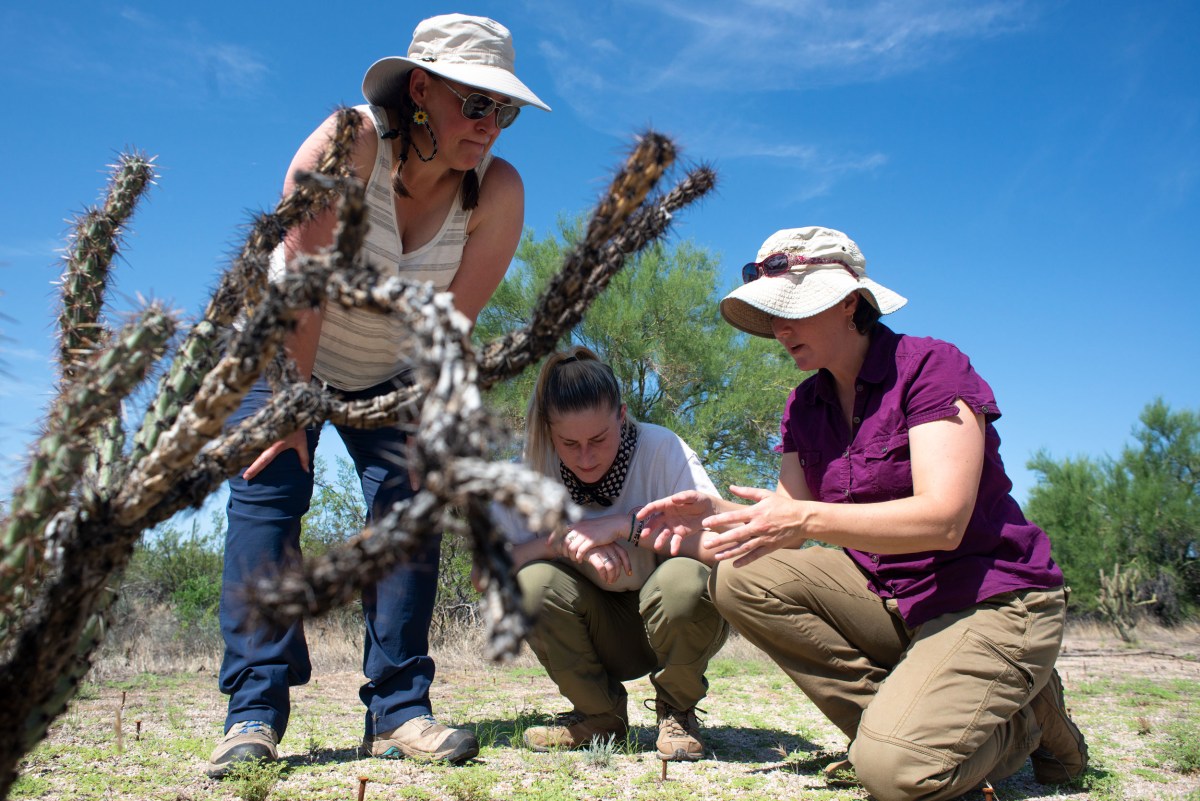Restoring biocrusts to fight valley fever

Antoninka, Barker, and Rowe use PPP funding to prevent disease by healing soil
When it comes to reducing the cases of Valley fever, one of the solutions may lie in the biocrust. Or, more precisely, the wind not blowing the biocrust.
Valley fever, or coccidioidomycosis, is a fungal disease caused by inhaling spores that live in the soil. The cocci, which are spherical-shaped bacteria, become airborne if the soil is disturbed and then blown as it is during farming, construction, mineral exploration, or other activities that break up the biocrust and leave it prone to erosion.
Anita Antoninka, assistant professor, NAU Department of Forestry, said that biocrusts bind the soil surface, protecting it from soil disturbance and dust.
“When soil is bound together with plant roots, fungal hyphae, biocrust cover or organic material, it is not easily moved by wind and water,” she said. “In the Sonoran Desert, biocrusts bind the soil in plant interspaces.”
Antoninka recently completed project funded by the Southwest Health Equity Research Collaborative through the Pilot Project Program (PPP), with Bridget Barker and Helen Rowe as co-investigators, titled “Testing the Utility of Biocrust Restoration to Stabilize Soils and Reduce Coccidioides Abundance.”
Through the PPP project, the team tested several methods of restoring biocrusts from field-collected and cultivated biocrusts in a Valley fever hotspot near Scottsdale to determine which methods best mitigate dust from soil and reduce the abundance of Coccidioides, which is the fungus that causes coccidioidomycosis, either directly or through competition with the soil microbial community.
Antoninka said that without the PPP funding, she would not have been able to pursue this new and important research direction.
“We think the implications are important and we will keep working on developing best methods and delivering the information and technology to communities that can benefit,” she said. “In addition, as a researcher, this PPP offered amazing support and training to improve my grant writing, grow my network and build my career.”
Avoiding valley fever
According to the Arizona Department of Health Services there were 9,833 cases of Valley fever reported last year in Arizona, though most people with Valley fever, approximately 60 percent, have no symptoms or only very mild flu-like symptoms and do not see a doctor.
The most common symptoms are fatigue, cough, fever, sweating at night, loss of appetite, chest pain, and muscle and joint aches, particularly of the ankles and knees. There may also be a rash that resembles hives but appears more often as tender red bumps on the shins or forearms.
People with chronic Valley fever infections have long-lasting symptoms such as low-grade fever, weight loss, cough, chest pain and coughing up blood. Since Valley fever is caused by breathing in airborne spores of Coccidioides, Antoninka said it is important to pay attention to blowing dust.
“The best way to avoid that is to avoid exposure to airborne soil,” Antoninka said. “Stay out of disturbed areas when it is windy and wear a mask when working in desert soil.”
Testing biocrusts for Coccidioides organisms
For her project, Antoninka and her team looked for cocci in areas with and without biocrust and across a gradient of ground cover. While cocci were found on-site (in burrows and disturbed soil), it was not detected in any biocrust plots.
“Marieke Ramsey, a master’s student, has taken this to the lab and has set up an experiment with cultivated biocrusts in conical tubes where she has injected cocci spores into intact, broken or control tubes,” she said. “Her preliminary results are encouraging, suggesting that biocrust reduces the ability of cocci to get airborne.”
Antoninka and her team have been testing methods to restore damaged biocrusts to mitigate erosion and dust. They are examining a variety of ways to cultivate biocrust and to maximize field collection of intact biocrust.
“Cultivating in the field and greenhouse is effective and fast,” she said.
They have also been working on a variety of methods to improve field establishment of biocrusts after they are cultivated. Growing biocrusts on burlap allows them to transplant an intact “island” of biocrust that is also beneficial to weed abatement and to the establishment of native plants. They are using natural soil “glues” to hold the biocrust in place after inoculating it.
“It can take some time for the biocrust to bind to soil given the limited periods of time that biocrusts are active in deserts,” she said.
The team has also been working on pelletizing biocrusts, much like a seed ball, to allow them to stay in place until conditions are optimal to establish them.
“All of these methods are good at reducing soil erosion and dust,” Antoninka said. “Essentially, anything that gets biocrust established will keep soils in place.”
Antoninka said Valley fever likely affects people who are underrepresented disproportionately because they have higher exposure to airborne soil due to housing and working locations, inadequate and delayed access to health care, and comorbidities that interact with the disease.
“All of this is potentially solvable by stabilizing soils with biocrust in cocci hotspots, increasing awareness about the disease in terms of causes, symptoms, diagnosis and symptoms, and improving equity and access to good healthcare,” she said.
Antoninka said that in the future, she and her team hope to test several hypotheses about using environmental remediation to reduce the incidence of disease.
“Our results are promising, and we are planning more research to determine the best larger-scale applications, as well as doing outreach to share our results with communities that could benefit from what we have learned,” she said. “We’ll be working on new funding avenues to further the research in the coming months.”
This research was supported by a National Institute on Minority Health and Health Disparities center grant to the Southwest Health Equity Research Collaborative at Northern Arizona University (U54MD012388).